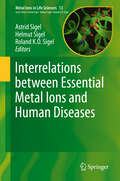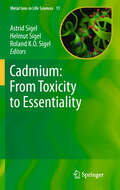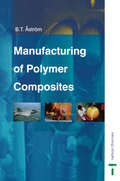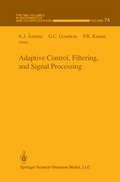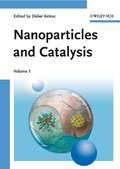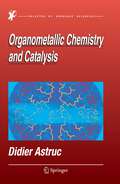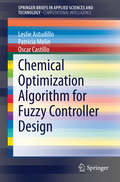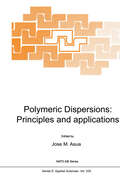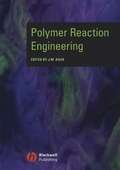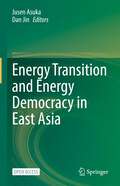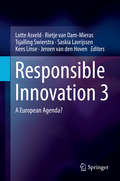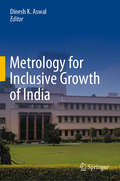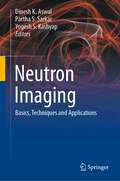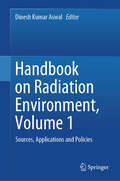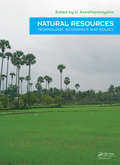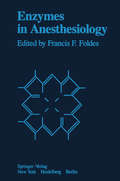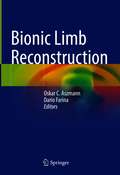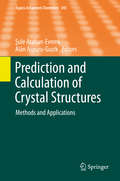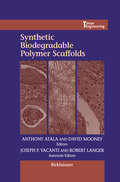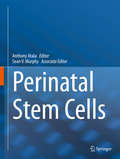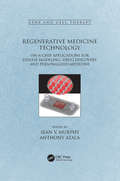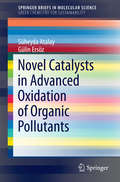- Table View
- List View
Interrelations between Essential Metal Ions and Human Diseases (Metal Ions in Life Sciences #13)
by Astrid Sigel, Helmut Sigel and Roland K. O. SigelMILS-13 provides an up-to-date review on the relationships between essential metals and human diseases, covering 13 metals and 3 metalloids: The bulk metals sodium, potassium, magnesium, and calcium, plus the trace elements manganese, iron, cobalt, copper, zinc, molybdenum, and selenium, all of which are essential for life. Also covered are chromium, vanadium, nickel, silicon, and arsenic, which have been proposed as being essential for humans in the 2nd half of the last century. However, if at all, they are needed only in ultra-trace amounts, and because of their prevalence in the environment, it has been difficult to prove whether or not they are required. In any case, all these elements are toxic in higher concentrations and therefore, transport and cellular concentrations of at least the essential ones, are tightly controlled; hence, their homeostasis and role for life, including deficiency or overload, and their links to illnesses, including cancer and neurological disorders, are thoroughly discussed. Indeed, it is an old wisdom that metals are indispensable for life. Therefore, Volume 13 provides in an authoritative and timely manner in 16 stimulating chapters, written by 29 internationally recognized experts from 7 nations, and supported by more than 2750 references, and over 20 tables and 80 illustrations, many in color, a most up-to-date view on the vibrant research area of the Interrelations between Essential Metal Ions and Human Diseases.
Cadmium: From Toxicity to Essentiality (Metal Ions in Life Sciences #11)
by Astrid Sigel, Helmut Sigel and Roland KO SigelVolume 11 provides in an authoritative and timely manner in 16 stimulating chapters, written by 40 internationally recognized experts from 11 nations, and supported by more than 2600 references, 35 tables, and over 100 illustrations, many in color, a most up-to-date view on the role of cadmium for life, presently a vibrant research area. MILS-11 covers the bioinorganic chemistry of Cd(II), its biogeochemistry, anthropogenic release into the environment, and speciation in the atmosphere, waters, soils, and sediments. The analytical tools for Cd determination, its imaging in cells, and the use of 113Cd NMR to probe Zn(II) and Ca(II) proteins are summarized, as are Cd(II) interactions with nucleotides, nucleic acids, amino acids, and proteins including metallothioneins. The phytoremediation by Cd(II)-accumulating plants, etc., the toxicology of Cd(II), its damage to mammalian organs, and its role as a carcinogen for humans, are highlighted.
Manufacturing of Polymer Composites
by B. Tomas AstromThe potential application areas for polymer composites are vast. While techniques and methodologies for composites design are relatively well established, the knowledge and understanding of post-design issues lag far behind. This leads to designs and eventually composites with disappointing properties and unnecessarily high cost, thus impeding a wider industrial acceptance of polymer composites. Manufacturing of Polymer Composites completely covers pre- and post-design issues. While the book enables students to become fully comfortable with composites as a possible materials choice, it also provides sufficient knowledge about manufacturing-related issues to permit them to avoid common pitfalls and unmanufacturable designs. The book is a fully comprehensive text covering all commercially significant materials and manufacturing techniques while at the same time discussing areas of research and development that are nearing commercial reality.
Manufacturing of Polymer Composites
by B. Tomas AstromThe potential application areas for polymer composites are vast. While techniques and methodologies for composites design are relatively well established, the knowledge and understanding of post-design issues lag far behind. This leads to designs and eventually composites with disappointing properties and unnecessarily high cost, thus impeding a wider industrial acceptance of polymer composites. Manufacturing of Polymer Composites completely covers pre- and post-design issues. While the book enables students to become fully comfortable with composites as a possible materials choice, it also provides sufficient knowledge about manufacturing-related issues to permit them to avoid common pitfalls and unmanufacturable designs. The book is a fully comprehensive text covering all commercially significant materials and manufacturing techniques while at the same time discussing areas of research and development that are nearing commercial reality.
Adaptive Control, Filtering, and Signal Processing (The IMA Volumes in Mathematics and its Applications #74)
by K. J. Aström G. C. Goodwin P. R. KumarThe area of adaptive systems, which encompasses recursive identification, adaptive control, filtering, and signal processing, has been one of the most active areas of the past decade. Since adaptive controllers are fundamentally nonlinear controllers which are applied to nominally linear, possibly stochastic and time-varying systems, their theoretical analysis is usually very difficult. Nevertheless, over the past decade much fundamental progress has been made on some key questions concerning their stability, convergence, performance, and robustness. Moreover, adaptive controllers have been successfully employed in numerous practical applications, and have even entered the marketplace.
Nanoparticles and Catalysis
by Didier AstrucWritten by international experts, this monograph combines two of the most important aspects of modern chemistry, presenting the latest knowledge on these environmental friendly applications. This result is a comprehensive overview of the application of nanoparticles in catalysis, focusing on synthesis and the most important reaction types, providing all the information needed by catalytic, organic and solid state chemists, as well as those working with or on organometallics, materials scientists, and chemists in industry.
Organometallic Chemistry and Catalysis
by Didier AstrucThis volume covers both basic and advanced aspects of organometallic chemistry of all metals and catalysis. In order to present a comprehensive view of the subject, it provides broad coverage of organometallic chemistry itself. The catalysis section includes the challenging activation and fictionalization of the main classes of hydrocarbons and the industrially crucial heterogeneous catalysis. Summaries and exercises are provides at the end of each chapter, and the answers to these exercises can be found at the back of the book. Beginners in inorganic, organic and organometallic chemistry, as well as advanced scholars and chemists from academia and industry will find much value in this title.
Chemical Optimization Algorithm for Fuzzy Controller Design (SpringerBriefs in Applied Sciences and Technology)
by Leslie Astudillo Patricia Melin Oscar CastilloIn this book, a novel optimization method inspired by a paradigm from nature is introduced. The chemical reactions are used as a paradigm to propose an optimization method that simulates these natural processes. The proposed algorithm is described in detail and then a set of typical complex benchmark functions is used to evaluate the performance of the algorithm. Simulation results show that the proposed optimization algorithm can outperform other methods in a set of benchmark functions.This chemical reaction optimization paradigm is also applied to solve the tracking problem for the dynamic model of a unicycle mobile robot by integrating a kinematic and a torque controller based on fuzzy logic theory. Computer simulations are presented confirming that this optimization paradigm is able to outperform other optimization techniques applied to this particular robot application.
Polymeric Dispersions: Principles and Applications (NATO Science Series E: #335)
by J. M. AsuaA comprehensive and up to date survey of the science and technology of polymeric dispersions. The book discusses the kinetics and mechanisms of polymerization in dispersed media, examines the processes controlling particle morphology, presents both off-line and on-line methods for the characterization of polymer colloids, considers reactor engineering and control, and covers a wide variety of applications, such as latex paint formulations, encapsulation of inorganic particles, reactive latexes, adhesives, paper coating, and biomedical and pharmaceutical applications. Audience: A valuable resource for scientists and engineers, academic and industrial, who are involved in the manufacture or application of polymeric dispersions.
Polymer Reaction Engineering
by Jose AsuaPolymers are an example of “products-by-process”, where the final product properties are mostly determined during manufacture, in the reactor. An understanding of processes occurring in the polymerization reactor is therefore crucial to achieving efficient, consistent, safe and environmentally friendly production of polymeric materials. Polymer Reaction Engineering provides the link between the fundamentals of polymerization kinetics and polymer microstructure achieved in the reactor. Organized according to the type of polymerization, each chapter starts with a description of the main polymers produced by the particular method, their key microstructural features and their applications Polymerization kinetics and its effect on reactor configuration, mass and energy balances and scale-up are covered in detail. The text is illustrated with examples emphasizing general concepts, principles and methodology. Written as an authoritative guide for chemists and chemical engineers in industry and academe, Polymer Reaction Engineering will also be a key reference source for advanced courses in polymer chemistry and technology.
Energy Transition and Energy Democracy in East Asia
by Jusen Asuka Dan JinThis is an open access book.The subject of this book is to provide down-to-earth information on what kind of actions are being taken by the Government, Local community, Businesses, Researchers, NGOs on the energy transition in this region. It gives an updated picture of the energy transition in the East Asian countries, where the economic growth, as well as CO2 emission growth, is significant.This book focuses not only on the technological perspective of the energy transition but also on the relationship between democracy and energy transition. Readers of this book can understand what kind of international support and pressure is needed to promote the energy transition in this region.Since energy transition is needed not only for combatting climate change but also for the Green Recovery from the COVID-19 pandemic, publishing this book is very helpful to promote the Green Recovery and the Green New Deal world-widely.
Responsible Innovation 3: A European Agenda?
by Lotte Asveld Rietje van Dam-Mieras Tsjalling Swierstra Saskia Lavrijssen Kees Linse Jeroen van den HovenThis book offers a comprehensive overview of current developments in the field of Responsible Research and Innovation (RRI). Divided into three parts, the book first presents reflections on the concept of RI from various angles: how did it come about, who is involved and how might in be applied in various contexts, such as the academic environment or in developing countries. The second part discusses the actual application of RRI to technology development: for climate engineering, water management and energy technology along with a general discussion on how to integrate RRI in innovation trajectories. The last part offers a closer look at the application of RRI to the business context. This part offers lessons from comparable concepts such as social and sustainability innovation as well as insights from two case-studies, one in the food sector and the other in data management. As a whole, the book contributes to the ongoing development of the framework of RRI by giving an overview of the state-of-the art research, presenting the lessons learned from several case studies, and showing the way for future application of RI in other fields and cultural contexts, such as industry and developing countries.
Metrology for Inclusive Growth of India
by Dinesh K. AswalThis book describes the significance of metrology for inclusive growth in India and explains its application in the areas of physical–mechanical engineering, electrical and electronics, Indian standard time measurements, electromagnetic radiation, environment, biomedical, materials and Bhartiya Nirdeshak Dravyas (BND®). Using the framework of “Aswal Model”, it connects the metrology, in association with accreditation and standards, to the areas of science and technology, government and regulatory agencies, civil society and media, and various other industries. It presents critical analyses of the contributions made by CSIR-National Physical Laboratory (CSIR-NPL), India, through its world-class science and apex measurement facilities of international equivalence in the areas of industrial growth, strategic sector growth, environmental protection, cybersecurity, sustainable energy, affordable health, international trade, policy-making, etc. The book will be useful for science and engineering students, researchers, policymakers and entrepreneurs.
Neutron Imaging: Basics, Techniques and Applications
by Dinesh K. Aswal Partha S. Sarkar Yogesh S. KashyapThis book comprehensively presents the concepts of neutron physics and imaging including neutron properties, neutron matter interaction, neutron imaging, comparison with X-ray and physics and design of neutron sources. It discusses how neutron imaging has gained importance as a powerful non-destructive technique to understand the internal structures of materials/engineered components in wide range of industries by increasing their applicability and efficiency. The book also covers the topics of neutron optics and detectors, basic principles of neutron radiography and tomography, related standards, safety, metrology and regulations in neutron imaging. The book presents applications of neutron imaging in the areas of aerospace industry, nuclear power and manufacturing industry, materials science and engineering, geomechanics, national security, biological, and medical domain. Given its scope, the book will be highly beneficial for postgraduate students, researchers and industry professionals working in the area of engineering and physics, especially non-destructive testing and non-destructive evaluation through neutron imaging.
Handbook on Radiation Environment, Volume 1: Sources, Applications and Policies
by Dinesh Kumar AswalThis handbook provides a comprehensive review of radiation present in the environment, its sources, dose measurement techniques, exposures in natural and man-made radiation environments, policies governing radiation safety, societal applications of radiation technology, radiological and nuclear events, preparedness, response, and mitigation of radiation emergencies. It covers natural and man-made radiation environment with an emphasis on renewed interest in nuclear energy as a clean and green source of power generation. Additionally, it reviews various approaches to understand the fate and behaviour of radionuclides in the terrestrial and aquatic ecosystems. It also presents nuclear technology's diverse applications, from diagnostic and therapeutic nuclear medicine to materials modifications and sustainable waste management strategies and the role of ionizing radiation in ensuring food security and safety. The handbook also highlights the existing (internationally adopted) radiation protection policies, which are originated from linear-no-threshold (LNT) model of dose-response characteristics. The scientific basis of LNT-model and its limitations at low doses prompts a revision of the exiting radiation protection policies for better utilization of the benefits of ionizing radiation. The handbook serves as a comprehensive resource for students, academicians, scientists, engineers, and policymakers interested in seeking an in-depth knowledge of radiation and the multifaceted applications of radiation technology while protecting human health and the environment.
Natural Resources - Technology, Economics & Policy
by U. AswathanarayanaNatural resources management has two principal dimensions : Science-illuminated (earth, space, hydrological, pedological, information, etc. sciences) management of local resources (waters, soils, bioresources, minerals, rocks, sediments, etc.) in an ecologically-sustainable manner, and Value-addition through processing of natural products, through
Energy Portfolios
by U. Aswathanarayana Rao S. DiviThis book provides an overview of the globally ongoing research and development efforts to reduce carbon emissions and costs, and to improve the efficiency of emerging energy technologies. It covers current and future research and development of Coal, Oil, Natural Gas, Nuclear Power, and Renewable Energy Resources. The author provides optimal size,
Enzymes in Anesthesiology
by A. A. Aszalos F. F. Foldes L. C. Mark S. H. Ngai R. W. Patterson J. M. Perel S. F. Sullivan L. Triner E. K. ZsigmondIt is a pleasure to have the privilege of writing the foreword for a book edited by Dr. Francis F. Foldes. Dr. Foldes has collected in one convenient place a discussion and description of enzyme systems of use to the anesthesiologist and to those other individuals, such as undergraduate and graduate students in related basic sciences, who will profit by and can make use of this body of information. The practicing anesthesiologist and those who work in related fields have become increasingly aware of the need to understand enzyme activities which influence the uptake, distribution, and excretion of those substances that are used in the anesthetic management of surgical patients. A variety of such is obvious when one considers that such diverse substances as activities and muscle re analgesic drugs, tranquilizers, hypnotics, anesthetic agents, laxants are strongly affected by these systems and have an influence over the basic understanding of how these drugs operate and act in the body, as well as providing a safety measure so necessary to the proper conduct of clinical anesthesia. The editor and his colleagues have rendered us a great service in collecting information that deals with the basic activity of enzymes including their structure, their kinetics, and to the degree that knowledge permits, mechanism of actions.
Bionic Limb Reconstruction
by Oskar C. Aszmann Dario FarinaThis book presents the latest techniques in amputation rehabilitation and summarizes the most recent research findings in the field of bionic limb reconstruction. Divided into seven parts written by experts in the field, it provides valuable information on e.g. upper extremity injuries, psychological considerations, prosthetic engineering, and surgical and rehabilitation strategies. Illustrative figures and photos of real-life settings further assist understanding. This book is of interest not only for plastic surgeons, but also for hand surgeons, orthopedic and trauma surgeons as well as therapists, prosthetists and engineers.
Prediction and Calculation of Crystal Structures: Methods and Applications (Topics in Current Chemistry #480)
by Sule Atahan-Evrenk Alan Aspuru-GuzikThe series Topics in Current Chemistry presents critical reviews of the present and future trends in modern chemical research. The scope of coverage is all areas of chemical science including the interfaces with related disciplines such as biology, medicine and materials science. The goal of each thematic volume is to give the non-specialist reader, whether in academia or industry, a comprehensive insight into an area where new research is emerging which is of interest to a larger scientific audience. Each review within the volume critically surveys one aspect of that topic and places it within the context of the volume as a whole. The most significant developments of the last 5 to 10 years are presented using selected examples to illustrate the principles discussed. The coverage is not intended to be an exhaustive summary of the field or include large quantities of data, but should rather be conceptual, concentrating on the methodological thinking that will allow the non-specialist reader to understand the information presented. Contributions also offer an outlook on potential future developments in the field. Review articles for the individual volumes are invited by the volume editors. Readership: research chemists at universities or in industry, graduate students.
Synthetic Biodegradable Polymer Scaffolds (Tissue engineering)
by Anthony Atala David J. MooneyThis body of work represents the first volume of a book series covering the field of tissue engineering. Tissue engineering, which refers to a category of therapeutic or diagnostic products and processes which are based upon a combination of living cells and biomaterials, was defined as a field only a few years ago (1988). Tissue engineering is an inherently interdisciplinary field, combining bioengineering, life sciences and clinical sciences. The definition of this area of work as the field of tissue engineering brought together scientists from multiple backgrounds who already were working toward the achievement of similar goals. Why a book series exclusively devoted to tissue engineering? The field of tissue engineering is heterogeneous. The cells involved in tissue engineering can be autologous, allogeneic or xenogeneic. The biomaterials utilized can be either naturally occurring, synthetic or a combination of both. The appli cation of the technology can be either for acute or permanent purposes. An attempt to cover the field of tissue engineering in a single volume, with the degree of detail necessary for individuals with different scientific back grounds and disciplines, would be a difficult task to accomplish, particularly when this field is just emerging and changing rapidly. Therefore, addressing different technologies within the field of tissue engineering, in a comprehen sive manner, is the main mission of this series of volumes. A stellar group of scientists has been brought together to form the editorial board of the series.
Perinatal Stem Cells
by Anthony Atala Sean V. MurphyThis comprehensive volume is one of the first books to offer the reader detailed insight into sources of perinatal stem cells, their biology, and their potential for disease treatment. It examines the research and therapeutic applications of perinatal stem cells including the treatment of renal disease, hematopoietic regeneration, cardiac disease, inflammatory disease, bone regeneration, pulmonary disease, and the treatment of spinal cord injury. Further, the book discusses current progress in the manufacturing, banking and clinical translation of perinatal stem cells. Through this book, readers will gain a thorough understanding of the current pre-clinical and clinical applications of perinatal stem cells as well as the efforts to support the transition of perinatal stem cell therapies from laboratories to clinics.Perinatal Stem Cells contains thirty-two chapters written by internationally recognized leaders in stem cell research. It is organized into four sections covering amniotic fluid stem cells, placental and placental membrane stem cells, umbilical cord stem cells, and clinical translation. This cohesive structure provides an effective framework for detailed insight into this new frontier. Edited by Dr. Anthony Atala, one of the foremost experts in the field, and his co-editor Dr. Sean V. Murphy, this volume is a definitive work for stem cell research and its future implications. It is a key resource for all stem cell researchers, clinicians, and government and industry staff working in this dynamic and exciting field.
Regenerative Medicine Technology: On-a-Chip Applications for Disease Modeling, Drug Discovery and Personalized Medicine (Gene and Cell Therapy)
by Anthony Atala Sean V. MurphyMiniaturization in the fields of chemistry and molecular biology has resulted in the "lab-on-a-chip." Such systems are micro-fabricated devices capable of handling extremely small fluid volumes facilitating the scaling of single or multiple lab processes down to a microchip-sized format. The convergence of lab-on-a-chip technology with the field of cell biology facilitated the development of "organ-on-a-chip" systems. Such systems simulate the function of tissues and organs, having the potential to bypass some cell and animal testing methods. These technologies have generated high interest as applications for disease modeling and drug discovery. This book, edited by Drs. Sean Murphy and Anthony Atala, provides a comprehensive coverage of the technologies that have been used to develop organ-on-a-chip systems. Known leaders cover the basics to the most relevant and novel topics in the field, including micro-fabrication, 3D bio-printing, 3D cell culture techniques, biosensor design and microelectronics, micro-fluidics, data collection, and predictive analysis. The book describes specific tissue types amenable for disease modeling and drug discovery applications. Lung, liver, heart, skin and kidney "on-a-chip" technologies are included as well as a progress report on designing an entire "body-on-a-chip" system. Additionally, the book covers applications of various systems for modeling tissue-specific cancers, metastasis, and tumor microenvironments; and provides an overview of current and potential applications of these systems to disease modeling, toxicity testing, and individualized medicine.
Regenerative Medicine Technology: On-a-Chip Applications for Disease Modeling, Drug Discovery and Personalized Medicine (Gene and Cell Therapy)
by Anthony Atala Sean V. MurphyMiniaturization in the fields of chemistry and molecular biology has resulted in the "lab-on-a-chip." Such systems are micro-fabricated devices capable of handling extremely small fluid volumes facilitating the scaling of single or multiple lab processes down to a microchip-sized format. The convergence of lab-on-a-chip technology with the field of cell biology facilitated the development of "organ-on-a-chip" systems. Such systems simulate the function of tissues and organs, having the potential to bypass some cell and animal testing methods. These technologies have generated high interest as applications for disease modeling and drug discovery. This book, edited by Drs. Sean Murphy and Anthony Atala, provides a comprehensive coverage of the technologies that have been used to develop organ-on-a-chip systems. Known leaders cover the basics to the most relevant and novel topics in the field, including micro-fabrication, 3D bio-printing, 3D cell culture techniques, biosensor design and microelectronics, micro-fluidics, data collection, and predictive analysis. The book describes specific tissue types amenable for disease modeling and drug discovery applications. Lung, liver, heart, skin and kidney "on-a-chip" technologies are included as well as a progress report on designing an entire "body-on-a-chip" system. Additionally, the book covers applications of various systems for modeling tissue-specific cancers, metastasis, and tumor microenvironments; and provides an overview of current and potential applications of these systems to disease modeling, toxicity testing, and individualized medicine.
Novel Catalysts in Advanced Oxidation of Organic Pollutants (SpringerBriefs in Molecular Science)
by Süheyda Atalay Gülin ErsözThis brief summarizes the role of certain catalysts and associated processes that are involved in the reduction or elimination of hazardous substances from wastewater and the exploitation of renewable raw materials. The authors begin by providing a summary of the most recent developments in catalysts used in the advanced oxidation of organic pollutants in aqueous phase. Advanced Oxidation Processes (AOPS) are described in terms of homogeneous and heterogeneous catalysts. Some emphasis is placed on the role nanocatalysts, perovskite-type catalysts, and green catalysts play in several AOPs such as Fenton Chemistry, photocatalytic oxidation, and the hybrid technologies that combine different processes. Catalyst preparation, characterization, reaction chemistry, and process technology are described. Specific wastewater case studies which illustrate the role of these catalysts in AOPs completes the brief.
